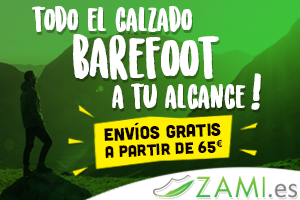- 03 Sep 2011, 21:55
#1793
Si,esas fueron las palabras de mi mujer cuando a las 8 am,la comente que me iba a correr.....
!!descalzo!!, e imagino que los que me vieron atravesar la pedanía murciana en donde vivo pensarian algo parecido y más aún si me han visto también este verano pasar corriendo a cuarenta y pico ºC .
Esa noche había tenido un calambre en un gemelo mientras dormía y también tenía molestías en un talón desde la semana anterior tras hacer 12 km, o sea que cuando me levanté tenía mis dudas de si salir a correr descalzo, pero lo hice. Sabría aplicar la "técnica" que había leido?. El cuerpo es muy sabio y desde las primeras zancadas "él sabia que hacer". Las molestias del talón las tenía al principio pero a lo 500 m.,más o menos desaparecieron . Fui por una carretera asfaltada que no tiene tráfico pero si tenía algo de arenilla que se notaba bastante y molestaba algo. Me sorprendió que cuando pisaba una china grande, instantáneamente y sin ser yo consciente, la pierna y cuerpo se doblaban más para amortiguar notándola muchisimo menos y con la carretera límpia iba perfectamente. A los 3 km y aunque estaba muy cómodo decidí volver, sobre todo porque, o bien mi mujer llamaba a urgencias podológicas si tardaba mucho o como me conozco habría seguido hasta los 10km o así y sé que mis piés lo pagarían.
Mis impresiones?...., todo bueno, me ha encantado, al parar noté las piernas relajadas y siempre las noto algo cargadas aunque solo fueron 3 km., el talón ha dejado de molestarme y los piés están muy bien ,solo tengo molestías en un dedo meñique. Conclusión: Estoy deseando volver a salir.
Un saludo
Tengo una duda que quizás me podaís resolver :
Lo de correr descalzo es (aparte de los beneficios fisicos que tenga) para adquirir mejor la técnia necesaria para usar las zapatillas minimalistas?
!!descalzo!!, e imagino que los que me vieron atravesar la pedanía murciana en donde vivo pensarian algo parecido y más aún si me han visto también este verano pasar corriendo a cuarenta y pico ºC .
Esa noche había tenido un calambre en un gemelo mientras dormía y también tenía molestías en un talón desde la semana anterior tras hacer 12 km, o sea que cuando me levanté tenía mis dudas de si salir a correr descalzo, pero lo hice. Sabría aplicar la "técnica" que había leido?. El cuerpo es muy sabio y desde las primeras zancadas "él sabia que hacer". Las molestias del talón las tenía al principio pero a lo 500 m.,más o menos desaparecieron . Fui por una carretera asfaltada que no tiene tráfico pero si tenía algo de arenilla que se notaba bastante y molestaba algo. Me sorprendió que cuando pisaba una china grande, instantáneamente y sin ser yo consciente, la pierna y cuerpo se doblaban más para amortiguar notándola muchisimo menos y con la carretera límpia iba perfectamente. A los 3 km y aunque estaba muy cómodo decidí volver, sobre todo porque, o bien mi mujer llamaba a urgencias podológicas si tardaba mucho o como me conozco habría seguido hasta los 10km o así y sé que mis piés lo pagarían.
Mis impresiones?...., todo bueno, me ha encantado, al parar noté las piernas relajadas y siempre las noto algo cargadas aunque solo fueron 3 km., el talón ha dejado de molestarme y los piés están muy bien ,solo tengo molestías en un dedo meñique. Conclusión: Estoy deseando volver a salir.
Un saludo
Tengo una duda que quizás me podaís resolver :
Lo de correr descalzo es (aparte de los beneficios fisicos que tenga) para adquirir mejor la técnia necesaria para usar las zapatillas minimalistas?

